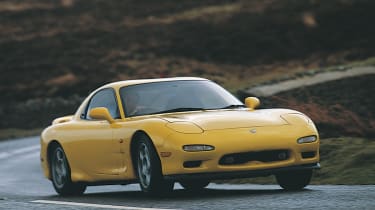BMW M5 v TVR Chimaera v Audi RS2 v Renault Clio V6 v Mazda RX-7 v Subaru Impreza v Lotus Espirit - Mazda RX-7
The revolutionary, but always thirsty, rotary engine marks the RX-7 apart from its peers. Great value, but is it be compelling when not driven flat-out?
The Tors Hotel sits high above Lynmouth Bay, and today it’s a spectacular view. Yesterday morning you couldn’t separate the cloud from the fog, the fog from the sea. Thick cloud still wraps the vista, but Justin Brittain’s searing yellow RX-7 acts like a ray of sunshine, breaking-up the oppressive grey scene. It wouldn’t be my pick of colour, but here and now it’s enough to lift my mood and raise the temperature a degree or two.
It’s in need of petrol (all you RX-7 owners will be familiar with this), and the nearest super-unleaded is in Minehead, 15 miles or so back across rolling moorland. I nab the keys and warm the twin-turbocharged twin-rotor engine as gently as I can. Rebuilt around 1000 miles ago (the rotary engine usually goes pop at around 60,000 miles) and fitted with a huge single exhaust, the engine feels fit and is very vocal. It’s maybe a bit loud for some, but the aftermarket pipe allows the engine to breathe better and at least injects some character into a usually anodyne engine note. When warm, each upshift is accompanied by a terrifying explosion.
This is an imported RX-7 Type-R, slightly lighter and stiffer than a UK-spec car and good for around 280bhp (the standard car has 237bhp). Sequential turbos give a wide power-band, the smaller of the two spooling up quickly and holding until around 4500rpm, where the bigger one takes over and boosts the rotary engine around to 8000rpm with ever-increasing intensity. After the laggy RS2, it’s superbly flexible and endows the RX-7 with real muscle.
But it’s the lightness, the grip and the response of the chassis that really mark out the RX-7 as something special. The tiny rotary engine is tucked well behind the front axle and all-up it weighs just 1270kg (add 30kg for a non-Type-R). When you first guide the front tyres towards an apex you can feel that lack of inertia and sense its perfect weight distribution. Understeer isn’t really an issue, and the quick, light steering is brimming with information, giving you the tools to attack.
So you start loading up the RX-7 on turn-in and jumping hard on the power as soon as the corner opens out. Even in damp conditions this Continental- shod Type-R (still on the original 16in rims) just grips and grips – the pay-off for its very stiff set-up. Fling it towards a corner and you can be confident that it’ll stick. There’s just enough roll to compress the tyres into the surface and let you know when you’re pushing hard; eventually a smidge of understeer signals the limit is close.
Push through and the bigger turbo starts to spin-up the rears, kicking the tail wide and holding it there as the revs quickly multiply. You need to hang with it, stay committed to throttle and steering correction, otherwise it feels clumsy as it suddenly grips again. But if you can hang on to the revs and the slide, the RX-7 feels deliciously poised. This isn’t gratuitous, lazy oversteer, but lightening-quick, efficient slip that helps keep the engine wound-up and the RX-7 flying.
Driven at this pace, aided by a tight gearbox and reassuring brake feel, the Mazda is more exhilarating than the TVR, more demanding than the slow-mo M5. It’s a shame that it feels more like an appliance at low speeds. In the Mazda it’s all or nothing.
Specifications
| Engine | twin-rotor, 1308cc, twin-turbo |
| Max power | 237bhp @ 6500rpm |
| Max torque | 218lb ft @ 5000rpm |
| Weight | 1310kg |
| Power/weight | 184bhp/ton |
| 0-60mph | 5.4sec |
| Max speed | 155mph (claimed) |



